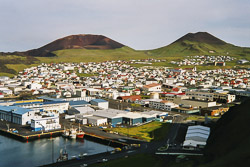The Westman Islands (Vestmannaeyjar)

The 15 small volcano islands of the Westman Archipelago are located about eight kilometres south of the Peninsula, spread over an area of 1,000 square kilometres. Most of them are only small rocks and uninhabitable for humans, yet they are nesting place for innumerable sea birds.
With 13.4 square kilometres, Heimaey is the biggest and only by humans inhabited Westman island. On its east side two cinder cones catch one’s eye. The most southern of both is the about 5,000 year old Helgafell and the northern Eldfell which was formed in 1973. Through its formation in 1973 the “fire mountain” Eldfell has made the Westman Islands popular worldwide.
Not far from the city, which counts around 5,000 inhabitants, a 1.6 kilometres long volcanic rift had opened in the morning of 23rd January. All inhabitants of the village could be evacuated in the same night. A few days later the rift was bundled to only a funnel, from which 1,100 centigrade hot lava was ejected. With the help of 6 million cubic metres of seawater, which was sprayed onto the lava stream, the village could finally be cooled down. Also the harbour entry, which was in danger of being buried, could be saved. However, the material damage was considerable. 400 houses were buried under the ashes and lava and several hundreds were damaged or destroyed. The island though was also enlarged through the lava outflow by 2.2 square kilometres.
The birth of a completely new island through a sub marine eruption in the years from 1963 to 1967, which started in 130 metres depth and carried on shortly after above sea level, shows that new land can accrue through volcanic activity. The first plants settle fairly quickly on the new land of lava and ashes. The new accrued island was named after the fire giant Surtur, who, according to Edda, came from the south and put the world on fire. ”Surtsey” is the most south island of the Westman archipelago and is being examined by geologists and biologists since its becoming. In the meantime it has also become clear, why plants could settle so quickly on this hostile piece of earth. Birds that nested there brought seeds in their coat onto the island, which fell into their nutritious dejection and this way plants could grow quickly. Until today the access to Surtsey is only granted to scientists. However, sightseeing flights start from Reykjavik from which one can view the young island from the air.

